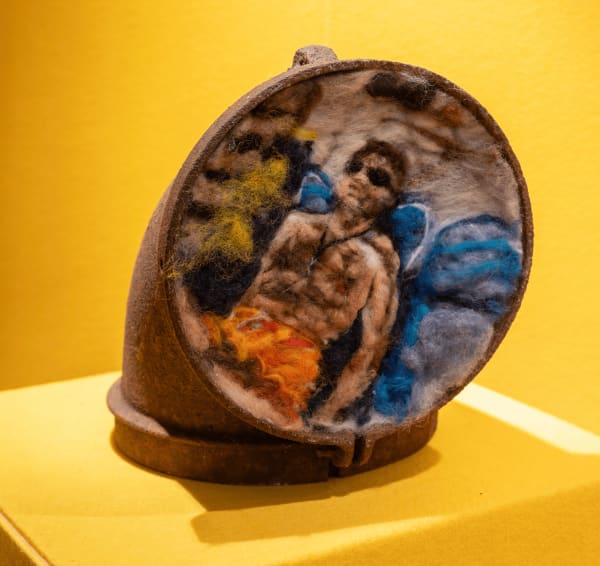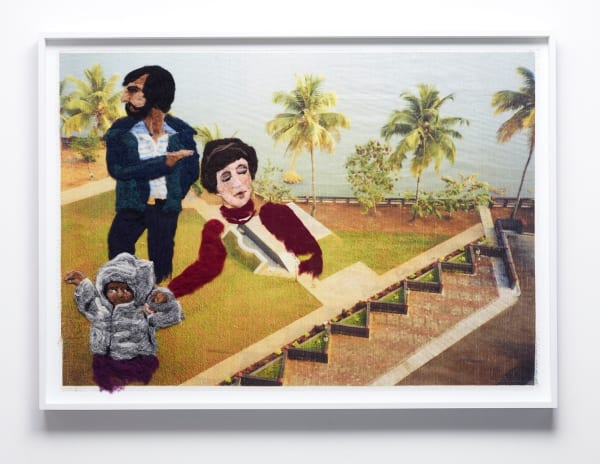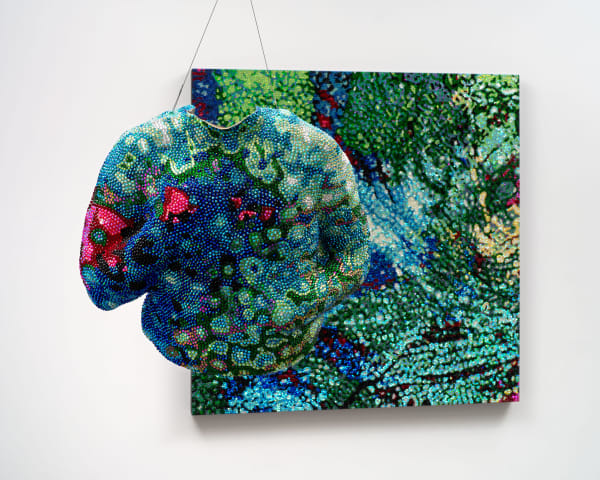We wake in the middle of a life, hungry
The opening of Jane Wong’s “After Preparing the Altar, the Ghosts Feast Feverishly.” Rapturous and visceral, the poem is a metaphorical call and response engaging gluttony and hunger across multiple generations, positioning life as a ravenous and relentless experience and encouraging the reader to stay rooted to home and inherited culture, but also to fly, to embrace, to take a bite, to smother themselves in the world. Using Wong’s poem as a point of departure, We wake in the middle of a life, hungry features the work of Allana Clarke, Melissa Joseph, Young Joon Kwak, Griselda Rosas, and Stacy Lynn Waddell, five female-identifying artists whose practices explore selfhood, identity, memory, and subjectivity, and whose work draws inspiration from their communities and their collaborative relationships.
Incorporating products associated with self-care and the beauty industry, Trinidadian-American artist Allana Clarke’s practice considers how culture, history, and memory can be conjured through materials. Primarily employing a liquid latex commonly used to adhere hair extensions onto a person’s scalp, Clarke’s three-dimensional wall mounted sculptures begin by pouring hair bonding glue onto panels made of window screens. The bonding glue cures from the top, while remaining supple underneath for days and even weeks. During that time, Clarke manipulates the material through scraping, pulling, twisting, and pushing with the whole of her body, transforming herself into a site for action and embedding her labor-intensive movements and gestures into the undulating forms that punctuate the work's surface. Clarke pioneered her performative sculptural method to create a tangible history of grappling with and moving through systems designed to denigrate conceptions of Blackness.
The fiber-based practice of Melissa Joseph foregrounds connection and relationships through collective memory and shared experience. Her work speaks to issues of diaspora – how family histories are shaped and maintained – and the politics that govern how physical and emotional spaces are occupied. Sourcing imagery directly from personal photographs of family members, friends, and peers, Joseph's unique dry-felting medium records intimate domestic settings and specific moments of togetherness. Bap in Puerto Rico pictures Joseph’s grandfather reclining on a beach and Dr. Joe’s Kitchen shows her father in his home. In each, felted panels are positioned within upcycled steel objects that metaphorically relate to the picture at hand – Bap is placed within the opening of a steel pipe and Dr. Joe in an anchor. A third work, What we leave behind, was recently highlighted in the British Textile Biennial and features felted portraits of the artist as a toddler and her parents over a photograph taken in a park when visiting the city of Kochi, Kerala India where her father was born and raised, printed on a Dupioni silk textile.
Through a multi-faceted practice rooted in sculpture, installation, and performance, Young Joon Kwak considers how our bodies are sites of constant transformation, and in a perpetual state of evolving and becoming. Hovering between abstraction and figuration, residing in a space of in-betweenness, Kwak’s sculptures require close looking. Composed of beads and mirrors that invite introspection through literal reflection, Kwak’s deliberate gesture towards openness and exchange results in the ability for their audience to simultaneously see and be seen. To See Your Self Reflected in Our Chameleonic Transformations (Neither Death Nor Dysphoria) is an amalgamation of colored rhinestones applied to the surface in a pattern that is inspired by the chimeric camouflaging qualities of the chameleon. The sculptural companion piece to Our Chameleonic – To Refuse Looking Away From Our Transitioning Bodies (Charlie With Chest Binder) – is a cast of the upper torso of a member of Kwak’s community whose “skin” has been outfitted with thousands of colored rhinestones. Both works were recently on view in Made in LA 2023: Acts of Living at the Hammer Museum, Los Angeles.
Griselda Rosas uses embroidery on textile and sculpture to reference inheritance and intergenerational knowledge, utilizing skills passed down within her family – from grandmother to mother to child. Often collaborating with her young son, whose drawings are a foundation from which she builds her own work, Rosas intricately renders embroideries of fantastical imaginary beings on upcycled grain bags. Embracing the imagery found on the grain sacks, Rosas integrates her compositions into the existing texts and corporate logos. These complex compositions speak to the circulation of culture, to systems of value, and labor. Other works within Rosas’ oeuvre speak to histories of colonialism and power through imagery culled directly from historical texts. Premonición – a large embroidery and acrylic work on faux ostrich skin – is an adaptation of historical colonial events in Central America. The figures in the foreground are extracted from E l Lienzo de Tlaxcala, an illustrated text produced by the Tlaxcallans documenting the Mesoamerican wars that occurred during the early to mid 1500s throughout what is now known as Central America.
Closely considering authorship and historical narratives, Stacy Lynn Waddell questions how recorded histories correspond to power structures, and speak to topical issues of visibility, desire, and power. Waddell’s subjects frequently include floral motifs, landscapes, and figuration, genres that follow the trends of global ‘Golden Ages’ – time periods often ascribed to the years immediately following a technological innovation that allows new forms of expression and new ideas - and manifested in varying geographies throughout Africa, North America, and Europe at different moments in time. Her works are made through experimental and alchemical processes including gold gilding and leafing, embossing and de-bossing, and gesture to value and trade and the distribution of wealth in the past and present. The optical effects of gold gilding are also fundamental to Waddell’s thinking, as the reflective material inherently requires viewers to continually shift their position in order to apprehend the work, which always remains inaccessible. This technique is utilized in Waddell’s WOMAN WITH AFRO LOOKING BACK and SENIOR FORMAL WITH FLOWER whereby found photographs are rendered in 22-karat gold leaf.
Tell us, little girl, are you hungry, awake, astonished enough?
-
 Allana Clarke, Can You Hear Me?, 2024
Allana Clarke, Can You Hear Me?, 2024 -
 Melissa Joseph, Bap in Puerto Rico, 2024
Melissa Joseph, Bap in Puerto Rico, 2024 -
 Melissa Joseph, Dr. Joe's Kitchen, 2024
Melissa Joseph, Dr. Joe's Kitchen, 2024 -
 Melissa Joseph, What we leave behind, 2023
Melissa Joseph, What we leave behind, 2023 -
 Young Joon Kwak, To See Your Self Reflected in Our Chameleonic Transformations (Neither Death Nor Dysphoria); To Refuse Looking Away From Our Transitioning Bodies (Charlie With Chest Binder), 2023
Young Joon Kwak, To See Your Self Reflected in Our Chameleonic Transformations (Neither Death Nor Dysphoria); To Refuse Looking Away From Our Transitioning Bodies (Charlie With Chest Binder), 2023 -
 Stacy Lynn Waddell, SENIOR FORMAL WITH FLOWER, 2024
Stacy Lynn Waddell, SENIOR FORMAL WITH FLOWER, 2024 -
 Stacy Lynn Waddell, WOMAN WITH AFRO LOOKING BACK, 2024
Stacy Lynn Waddell, WOMAN WITH AFRO LOOKING BACK, 2024 -
 Griselda Rosas, Premonición, 2024
Griselda Rosas, Premonición, 2024 -
 Griselda Rosas, Rudo, 2024
Griselda Rosas, Rudo, 2024
















